Implementation of Enterprise Architecture at Bank1: A Research Report
VerifiedAdded on 2022/09/29
|12
|3022
|27
Report
AI Summary
This report provides an analysis of enterprise architecture implementation at Bank1, an Australian bank. It identifies interpersonal challenges in the implementation process and defines the research aim to understand these challenges. The report explores two Information Systems (IS) research paradigms: positivist and interpretive, ultimately selecting the positivist approach. The justification for this selection is based on the suitability of the positivist method for investigating the objective and quantifiable aspects of the interpersonal interactions between architects and stakeholders. The report highlights the importance of this research in improving the success of enterprise architecture implementations by identifying obstacles, opportunities, and potential solutions. The report also discusses quantitative methods, empirical research, and the potential contributions of the study in the field of enterprise architecture. The study emphasizes the need for a strong theoretical framework and well-structured research questions to ensure effective outcomes. The report also touches upon the significance of the findings for project compliance, architectural insights, and the overall success of enterprise architecture initiatives.
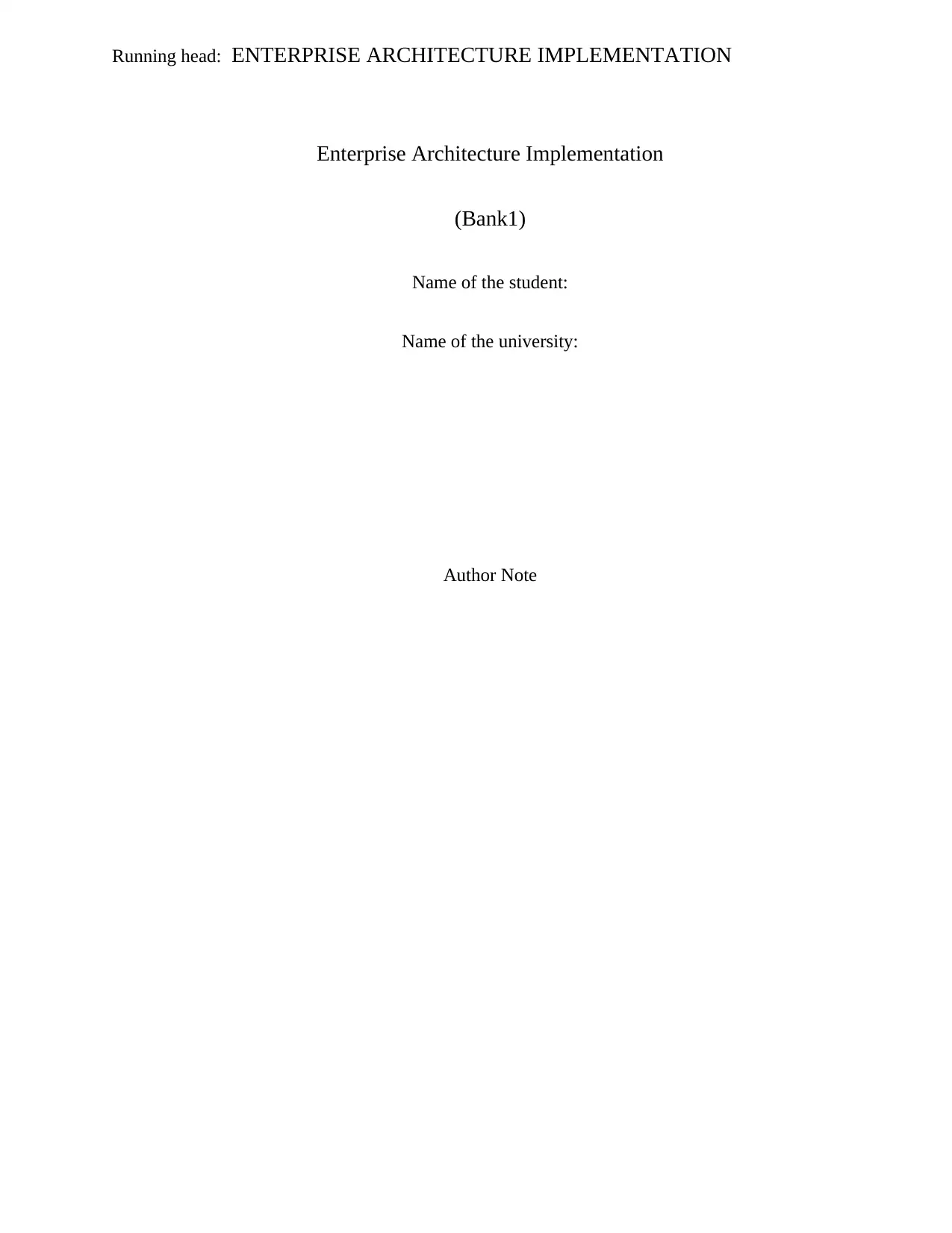
Running head: ENTERPRISE ARCHITECTURE IMPLEMENTATION
Enterprise Architecture Implementation
(Bank1)
Name of the student:
Name of the university:
Author Note
Enterprise Architecture Implementation
(Bank1)
Name of the student:
Name of the university:
Author Note
Paraphrase This Document
Need a fresh take? Get an instant paraphrase of this document with our AI Paraphraser
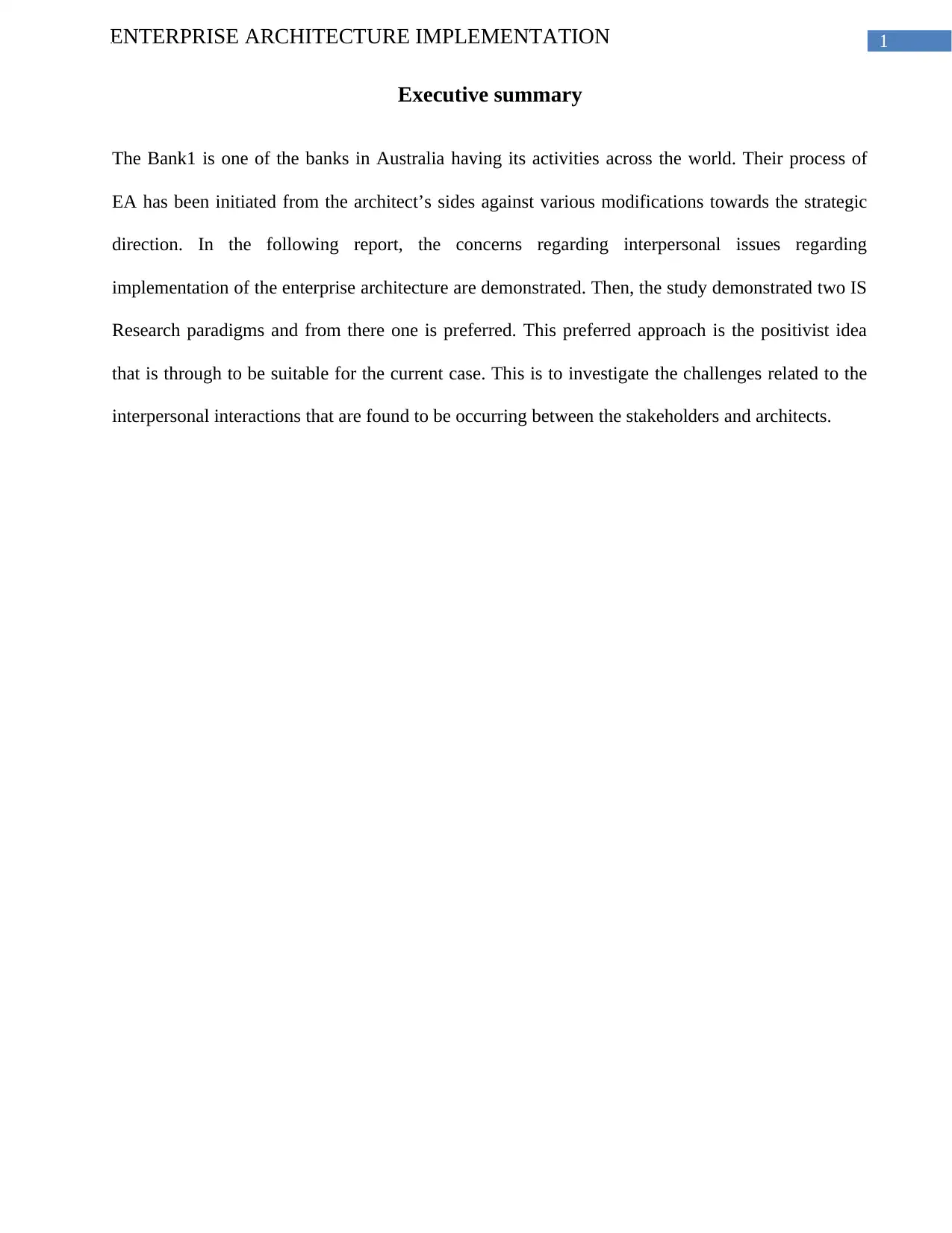
1ENTERPRISE ARCHITECTURE IMPLEMENTATION
Executive summary
The Bank1 is one of the banks in Australia having its activities across the world. Their process of
EA has been initiated from the architect’s sides against various modifications towards the strategic
direction. In the following report, the concerns regarding interpersonal issues regarding
implementation of the enterprise architecture are demonstrated. Then, the study demonstrated two IS
Research paradigms and from there one is preferred. This preferred approach is the positivist idea
that is through to be suitable for the current case. This is to investigate the challenges related to the
interpersonal interactions that are found to be occurring between the stakeholders and architects.
Executive summary
The Bank1 is one of the banks in Australia having its activities across the world. Their process of
EA has been initiated from the architect’s sides against various modifications towards the strategic
direction. In the following report, the concerns regarding interpersonal issues regarding
implementation of the enterprise architecture are demonstrated. Then, the study demonstrated two IS
Research paradigms and from there one is preferred. This preferred approach is the positivist idea
that is through to be suitable for the current case. This is to investigate the challenges related to the
interpersonal interactions that are found to be occurring between the stakeholders and architects.
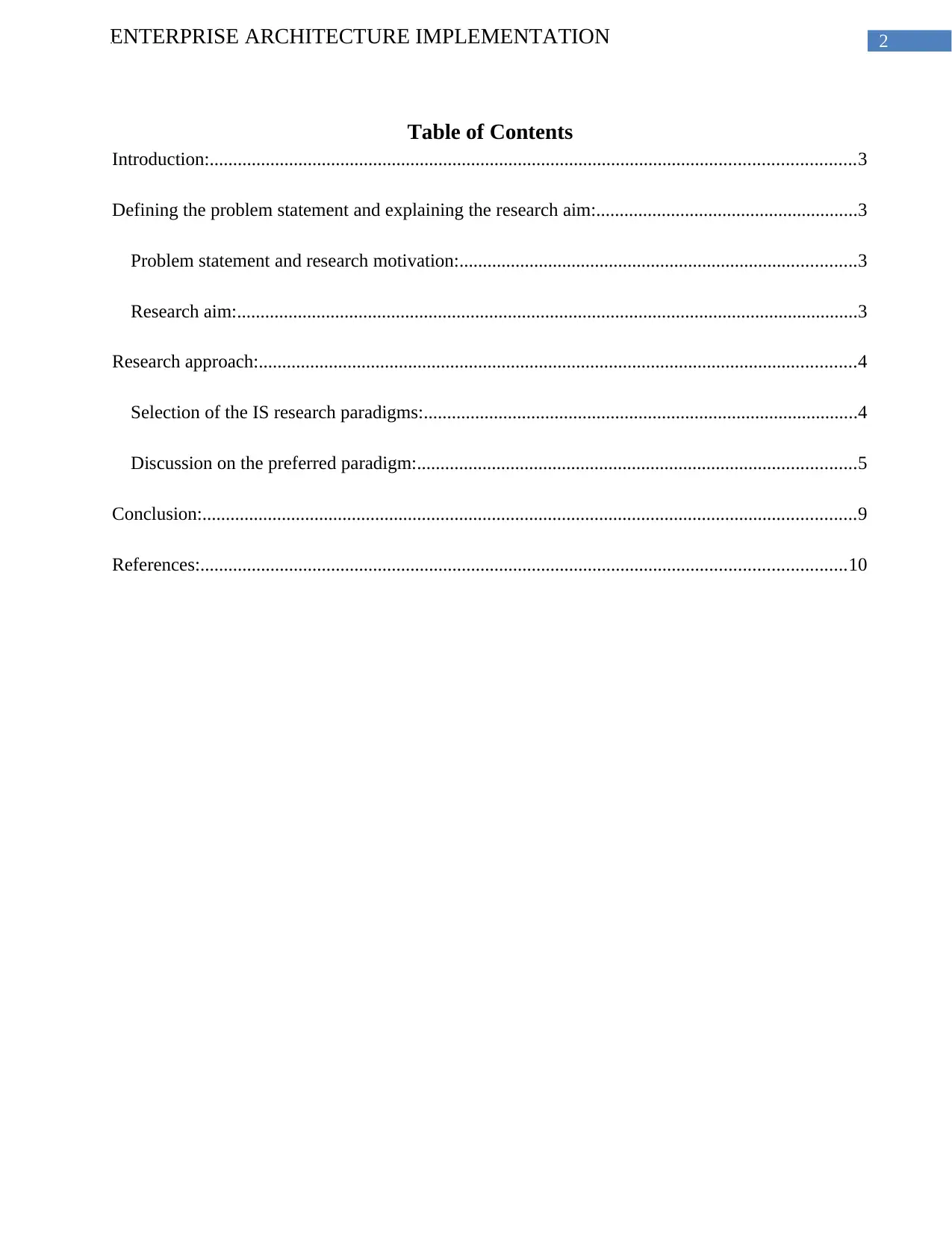
2ENTERPRISE ARCHITECTURE IMPLEMENTATION
Table of Contents
Introduction:..........................................................................................................................................3
Defining the problem statement and explaining the research aim:........................................................3
Problem statement and research motivation:.....................................................................................3
Research aim:.....................................................................................................................................3
Research approach:................................................................................................................................4
Selection of the IS research paradigms:.............................................................................................4
Discussion on the preferred paradigm:..............................................................................................5
Conclusion:............................................................................................................................................9
References:..........................................................................................................................................10
Table of Contents
Introduction:..........................................................................................................................................3
Defining the problem statement and explaining the research aim:........................................................3
Problem statement and research motivation:.....................................................................................3
Research aim:.....................................................................................................................................3
Research approach:................................................................................................................................4
Selection of the IS research paradigms:.............................................................................................4
Discussion on the preferred paradigm:..............................................................................................5
Conclusion:............................................................................................................................................9
References:..........................................................................................................................................10
⊘ This is a preview!⊘
Do you want full access?
Subscribe today to unlock all pages.

Trusted by 1+ million students worldwide
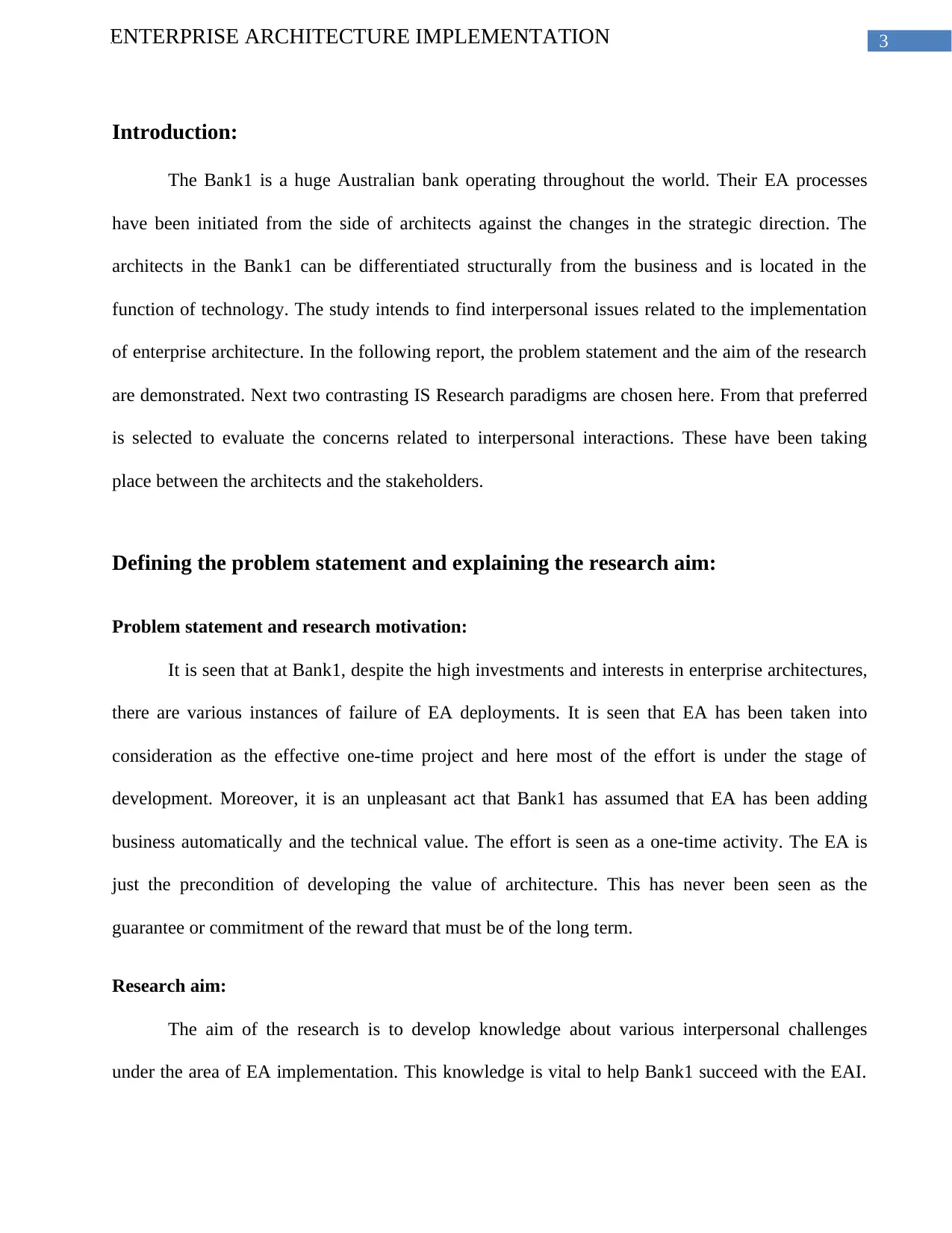
3ENTERPRISE ARCHITECTURE IMPLEMENTATION
Introduction:
The Bank1 is a huge Australian bank operating throughout the world. Their EA processes
have been initiated from the side of architects against the changes in the strategic direction. The
architects in the Bank1 can be differentiated structurally from the business and is located in the
function of technology. The study intends to find interpersonal issues related to the implementation
of enterprise architecture. In the following report, the problem statement and the aim of the research
are demonstrated. Next two contrasting IS Research paradigms are chosen here. From that preferred
is selected to evaluate the concerns related to interpersonal interactions. These have been taking
place between the architects and the stakeholders.
Defining the problem statement and explaining the research aim:
Problem statement and research motivation:
It is seen that at Bank1, despite the high investments and interests in enterprise architectures,
there are various instances of failure of EA deployments. It is seen that EA has been taken into
consideration as the effective one-time project and here most of the effort is under the stage of
development. Moreover, it is an unpleasant act that Bank1 has assumed that EA has been adding
business automatically and the technical value. The effort is seen as a one-time activity. The EA is
just the precondition of developing the value of architecture. This has never been seen as the
guarantee or commitment of the reward that must be of the long term.
Research aim:
The aim of the research is to develop knowledge about various interpersonal challenges
under the area of EA implementation. This knowledge is vital to help Bank1 succeed with the EAI.
Introduction:
The Bank1 is a huge Australian bank operating throughout the world. Their EA processes
have been initiated from the side of architects against the changes in the strategic direction. The
architects in the Bank1 can be differentiated structurally from the business and is located in the
function of technology. The study intends to find interpersonal issues related to the implementation
of enterprise architecture. In the following report, the problem statement and the aim of the research
are demonstrated. Next two contrasting IS Research paradigms are chosen here. From that preferred
is selected to evaluate the concerns related to interpersonal interactions. These have been taking
place between the architects and the stakeholders.
Defining the problem statement and explaining the research aim:
Problem statement and research motivation:
It is seen that at Bank1, despite the high investments and interests in enterprise architectures,
there are various instances of failure of EA deployments. It is seen that EA has been taken into
consideration as the effective one-time project and here most of the effort is under the stage of
development. Moreover, it is an unpleasant act that Bank1 has assumed that EA has been adding
business automatically and the technical value. The effort is seen as a one-time activity. The EA is
just the precondition of developing the value of architecture. This has never been seen as the
guarantee or commitment of the reward that must be of the long term.
Research aim:
The aim of the research is to develop knowledge about various interpersonal challenges
under the area of EA implementation. This knowledge is vital to help Bank1 succeed with the EAI.
Paraphrase This Document
Need a fresh take? Get an instant paraphrase of this document with our AI Paraphraser
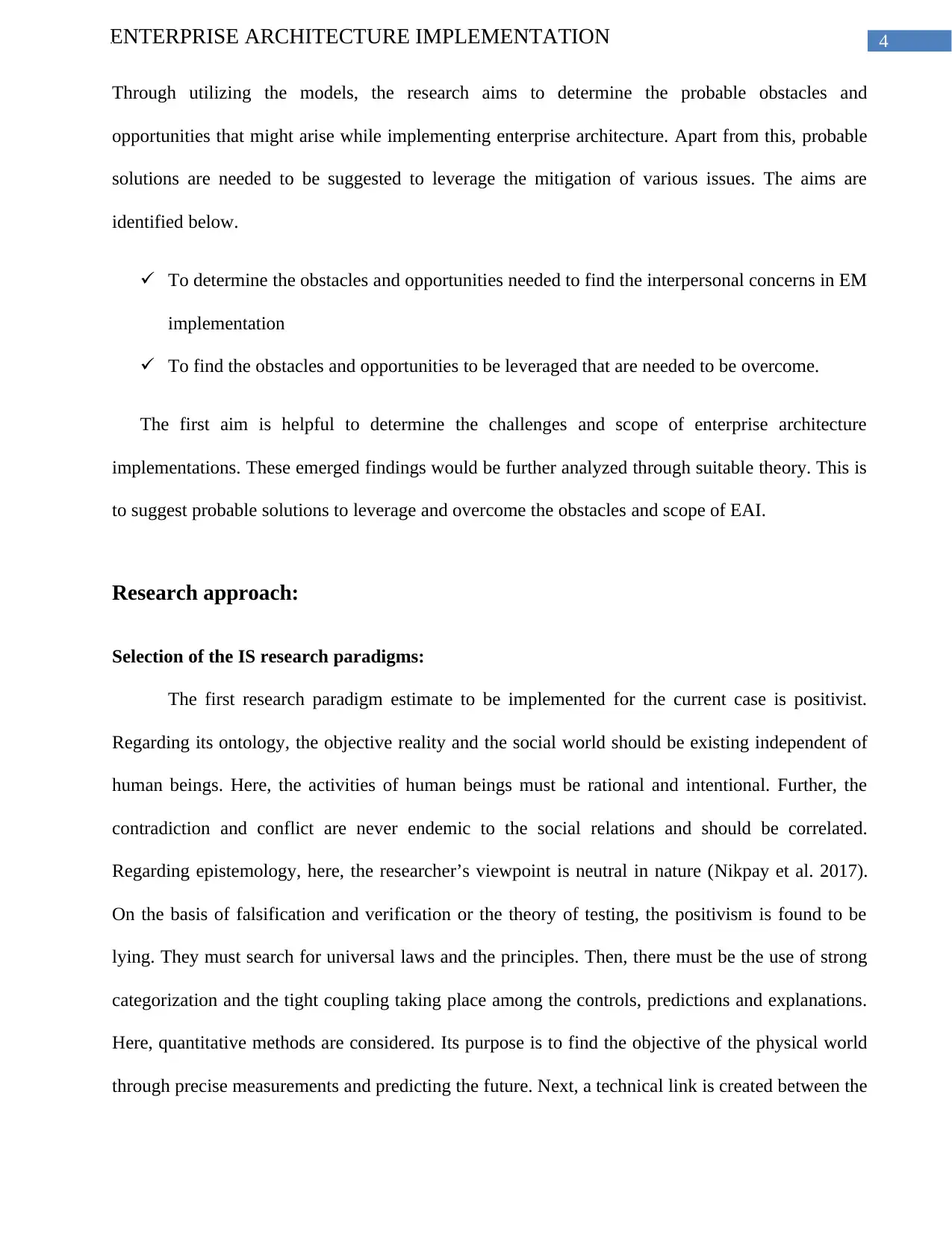
4ENTERPRISE ARCHITECTURE IMPLEMENTATION
Through utilizing the models, the research aims to determine the probable obstacles and
opportunities that might arise while implementing enterprise architecture. Apart from this, probable
solutions are needed to be suggested to leverage the mitigation of various issues. The aims are
identified below.
To determine the obstacles and opportunities needed to find the interpersonal concerns in EM
implementation
To find the obstacles and opportunities to be leveraged that are needed to be overcome.
The first aim is helpful to determine the challenges and scope of enterprise architecture
implementations. These emerged findings would be further analyzed through suitable theory. This is
to suggest probable solutions to leverage and overcome the obstacles and scope of EAI.
Research approach:
Selection of the IS research paradigms:
The first research paradigm estimate to be implemented for the current case is positivist.
Regarding its ontology, the objective reality and the social world should be existing independent of
human beings. Here, the activities of human beings must be rational and intentional. Further, the
contradiction and conflict are never endemic to the social relations and should be correlated.
Regarding epistemology, here, the researcher’s viewpoint is neutral in nature (Nikpay et al. 2017).
On the basis of falsification and verification or the theory of testing, the positivism is found to be
lying. They must search for universal laws and the principles. Then, there must be the use of strong
categorization and the tight coupling taking place among the controls, predictions and explanations.
Here, quantitative methods are considered. Its purpose is to find the objective of the physical world
through precise measurements and predicting the future. Next, a technical link is created between the
Through utilizing the models, the research aims to determine the probable obstacles and
opportunities that might arise while implementing enterprise architecture. Apart from this, probable
solutions are needed to be suggested to leverage the mitigation of various issues. The aims are
identified below.
To determine the obstacles and opportunities needed to find the interpersonal concerns in EM
implementation
To find the obstacles and opportunities to be leveraged that are needed to be overcome.
The first aim is helpful to determine the challenges and scope of enterprise architecture
implementations. These emerged findings would be further analyzed through suitable theory. This is
to suggest probable solutions to leverage and overcome the obstacles and scope of EAI.
Research approach:
Selection of the IS research paradigms:
The first research paradigm estimate to be implemented for the current case is positivist.
Regarding its ontology, the objective reality and the social world should be existing independent of
human beings. Here, the activities of human beings must be rational and intentional. Further, the
contradiction and conflict are never endemic to the social relations and should be correlated.
Regarding epistemology, here, the researcher’s viewpoint is neutral in nature (Nikpay et al. 2017).
On the basis of falsification and verification or the theory of testing, the positivism is found to be
lying. They must search for universal laws and the principles. Then, there must be the use of strong
categorization and the tight coupling taking place among the controls, predictions and explanations.
Here, quantitative methods are considered. Its purpose is to find the objective of the physical world
through precise measurements and predicting the future. Next, a technical link is created between the
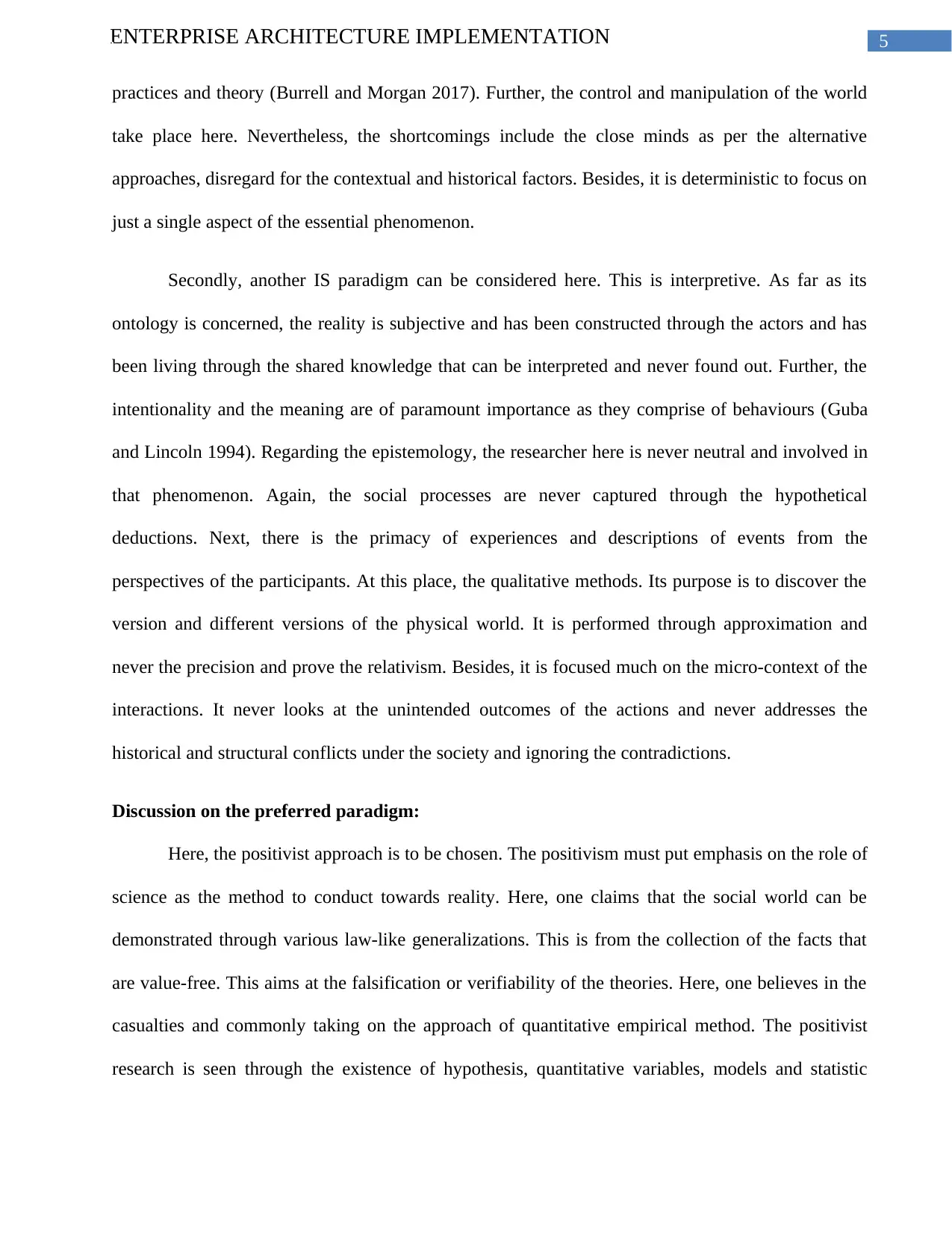
5ENTERPRISE ARCHITECTURE IMPLEMENTATION
practices and theory (Burrell and Morgan 2017). Further, the control and manipulation of the world
take place here. Nevertheless, the shortcomings include the close minds as per the alternative
approaches, disregard for the contextual and historical factors. Besides, it is deterministic to focus on
just a single aspect of the essential phenomenon.
Secondly, another IS paradigm can be considered here. This is interpretive. As far as its
ontology is concerned, the reality is subjective and has been constructed through the actors and has
been living through the shared knowledge that can be interpreted and never found out. Further, the
intentionality and the meaning are of paramount importance as they comprise of behaviours (Guba
and Lincoln 1994). Regarding the epistemology, the researcher here is never neutral and involved in
that phenomenon. Again, the social processes are never captured through the hypothetical
deductions. Next, there is the primacy of experiences and descriptions of events from the
perspectives of the participants. At this place, the qualitative methods. Its purpose is to discover the
version and different versions of the physical world. It is performed through approximation and
never the precision and prove the relativism. Besides, it is focused much on the micro-context of the
interactions. It never looks at the unintended outcomes of the actions and never addresses the
historical and structural conflicts under the society and ignoring the contradictions.
Discussion on the preferred paradigm:
Here, the positivist approach is to be chosen. The positivism must put emphasis on the role of
science as the method to conduct towards reality. Here, one claims that the social world can be
demonstrated through various law-like generalizations. This is from the collection of the facts that
are value-free. This aims at the falsification or verifiability of the theories. Here, one believes in the
casualties and commonly taking on the approach of quantitative empirical method. The positivist
research is seen through the existence of hypothesis, quantitative variables, models and statistic
practices and theory (Burrell and Morgan 2017). Further, the control and manipulation of the world
take place here. Nevertheless, the shortcomings include the close minds as per the alternative
approaches, disregard for the contextual and historical factors. Besides, it is deterministic to focus on
just a single aspect of the essential phenomenon.
Secondly, another IS paradigm can be considered here. This is interpretive. As far as its
ontology is concerned, the reality is subjective and has been constructed through the actors and has
been living through the shared knowledge that can be interpreted and never found out. Further, the
intentionality and the meaning are of paramount importance as they comprise of behaviours (Guba
and Lincoln 1994). Regarding the epistemology, the researcher here is never neutral and involved in
that phenomenon. Again, the social processes are never captured through the hypothetical
deductions. Next, there is the primacy of experiences and descriptions of events from the
perspectives of the participants. At this place, the qualitative methods. Its purpose is to discover the
version and different versions of the physical world. It is performed through approximation and
never the precision and prove the relativism. Besides, it is focused much on the micro-context of the
interactions. It never looks at the unintended outcomes of the actions and never addresses the
historical and structural conflicts under the society and ignoring the contradictions.
Discussion on the preferred paradigm:
Here, the positivist approach is to be chosen. The positivism must put emphasis on the role of
science as the method to conduct towards reality. Here, one claims that the social world can be
demonstrated through various law-like generalizations. This is from the collection of the facts that
are value-free. This aims at the falsification or verifiability of the theories. Here, one believes in the
casualties and commonly taking on the approach of quantitative empirical method. The positivist
research is seen through the existence of hypothesis, quantitative variables, models and statistic
⊘ This is a preview!⊘
Do you want full access?
Subscribe today to unlock all pages.

Trusted by 1+ million students worldwide
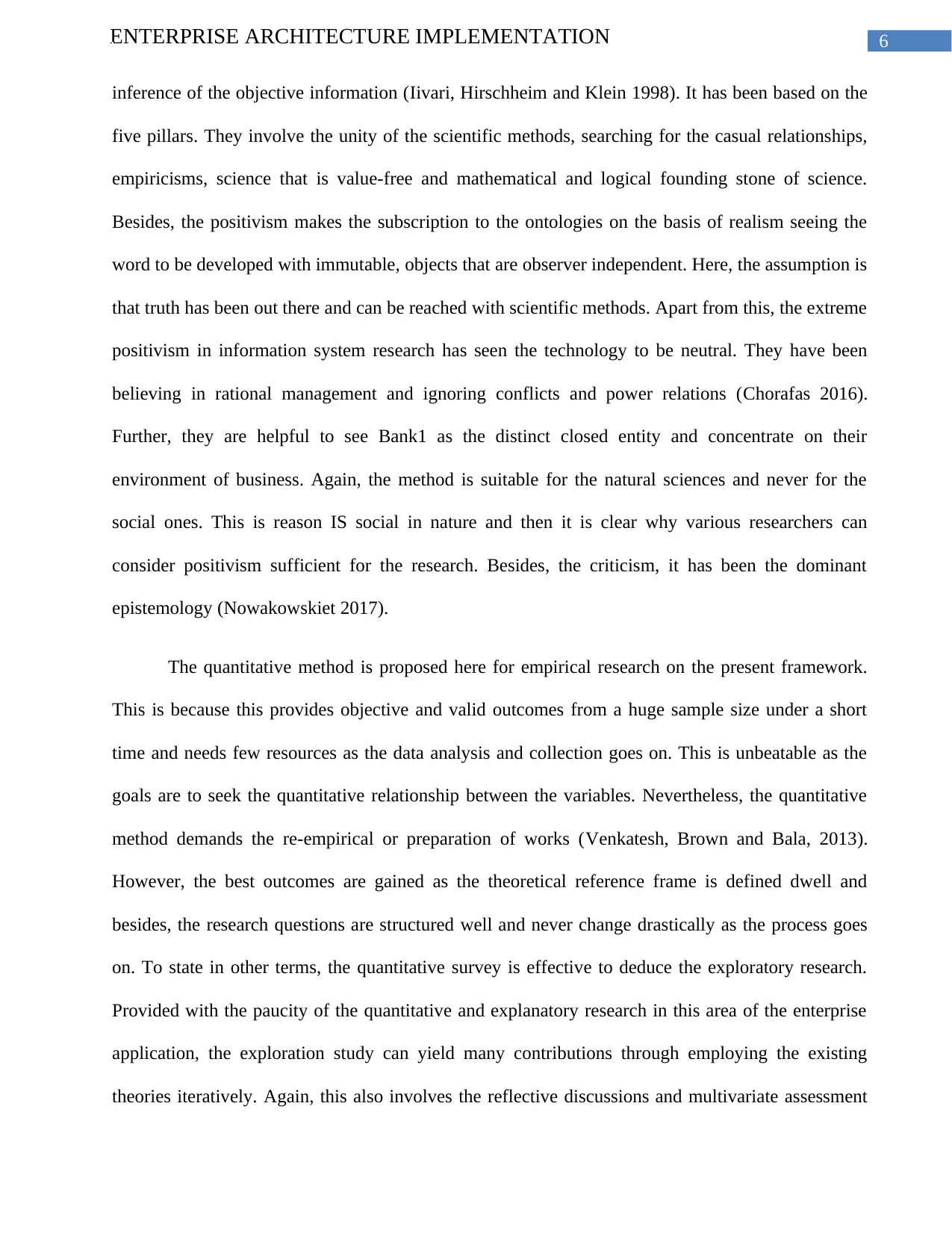
6ENTERPRISE ARCHITECTURE IMPLEMENTATION
inference of the objective information (Iivari, Hirschheim and Klein 1998). It has been based on the
five pillars. They involve the unity of the scientific methods, searching for the casual relationships,
empiricisms, science that is value-free and mathematical and logical founding stone of science.
Besides, the positivism makes the subscription to the ontologies on the basis of realism seeing the
word to be developed with immutable, objects that are observer independent. Here, the assumption is
that truth has been out there and can be reached with scientific methods. Apart from this, the extreme
positivism in information system research has seen the technology to be neutral. They have been
believing in rational management and ignoring conflicts and power relations (Chorafas 2016).
Further, they are helpful to see Bank1 as the distinct closed entity and concentrate on their
environment of business. Again, the method is suitable for the natural sciences and never for the
social ones. This is reason IS social in nature and then it is clear why various researchers can
consider positivism sufficient for the research. Besides, the criticism, it has been the dominant
epistemology (Nowakowskiet 2017).
The quantitative method is proposed here for empirical research on the present framework.
This is because this provides objective and valid outcomes from a huge sample size under a short
time and needs few resources as the data analysis and collection goes on. This is unbeatable as the
goals are to seek the quantitative relationship between the variables. Nevertheless, the quantitative
method demands the re-empirical or preparation of works (Venkatesh, Brown and Bala, 2013).
However, the best outcomes are gained as the theoretical reference frame is defined dwell and
besides, the research questions are structured well and never change drastically as the process goes
on. To state in other terms, the quantitative survey is effective to deduce the exploratory research.
Provided with the paucity of the quantitative and explanatory research in this area of the enterprise
application, the exploration study can yield many contributions through employing the existing
theories iteratively. Again, this also involves the reflective discussions and multivariate assessment
inference of the objective information (Iivari, Hirschheim and Klein 1998). It has been based on the
five pillars. They involve the unity of the scientific methods, searching for the casual relationships,
empiricisms, science that is value-free and mathematical and logical founding stone of science.
Besides, the positivism makes the subscription to the ontologies on the basis of realism seeing the
word to be developed with immutable, objects that are observer independent. Here, the assumption is
that truth has been out there and can be reached with scientific methods. Apart from this, the extreme
positivism in information system research has seen the technology to be neutral. They have been
believing in rational management and ignoring conflicts and power relations (Chorafas 2016).
Further, they are helpful to see Bank1 as the distinct closed entity and concentrate on their
environment of business. Again, the method is suitable for the natural sciences and never for the
social ones. This is reason IS social in nature and then it is clear why various researchers can
consider positivism sufficient for the research. Besides, the criticism, it has been the dominant
epistemology (Nowakowskiet 2017).
The quantitative method is proposed here for empirical research on the present framework.
This is because this provides objective and valid outcomes from a huge sample size under a short
time and needs few resources as the data analysis and collection goes on. This is unbeatable as the
goals are to seek the quantitative relationship between the variables. Nevertheless, the quantitative
method demands the re-empirical or preparation of works (Venkatesh, Brown and Bala, 2013).
However, the best outcomes are gained as the theoretical reference frame is defined dwell and
besides, the research questions are structured well and never change drastically as the process goes
on. To state in other terms, the quantitative survey is effective to deduce the exploratory research.
Provided with the paucity of the quantitative and explanatory research in this area of the enterprise
application, the exploration study can yield many contributions through employing the existing
theories iteratively. Again, this also involves the reflective discussions and multivariate assessment
Paraphrase This Document
Need a fresh take? Get an instant paraphrase of this document with our AI Paraphraser
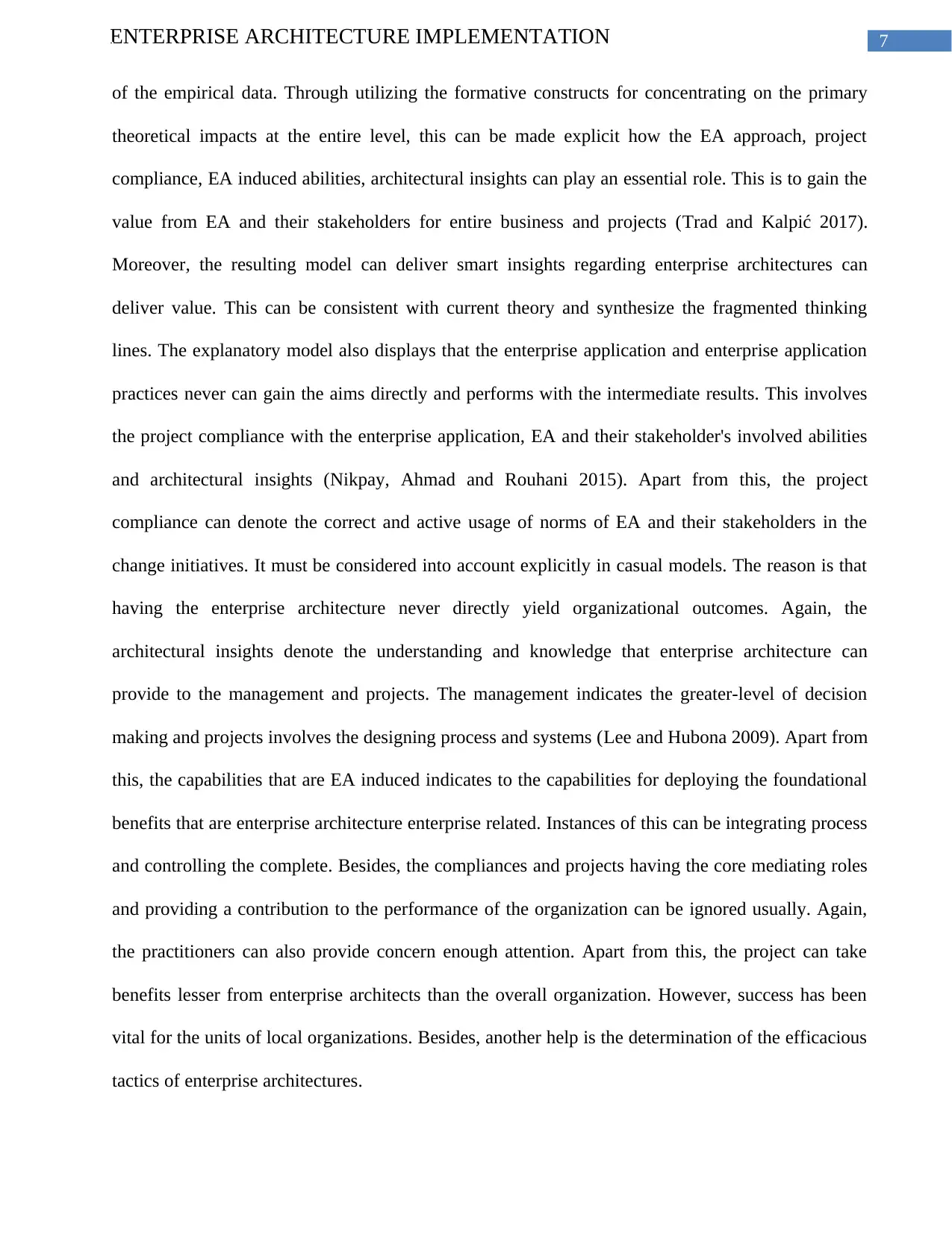
7ENTERPRISE ARCHITECTURE IMPLEMENTATION
of the empirical data. Through utilizing the formative constructs for concentrating on the primary
theoretical impacts at the entire level, this can be made explicit how the EA approach, project
compliance, EA induced abilities, architectural insights can play an essential role. This is to gain the
value from EA and their stakeholders for entire business and projects (Trad and Kalpić 2017).
Moreover, the resulting model can deliver smart insights regarding enterprise architectures can
deliver value. This can be consistent with current theory and synthesize the fragmented thinking
lines. The explanatory model also displays that the enterprise application and enterprise application
practices never can gain the aims directly and performs with the intermediate results. This involves
the project compliance with the enterprise application, EA and their stakeholder's involved abilities
and architectural insights (Nikpay, Ahmad and Rouhani 2015). Apart from this, the project
compliance can denote the correct and active usage of norms of EA and their stakeholders in the
change initiatives. It must be considered into account explicitly in casual models. The reason is that
having the enterprise architecture never directly yield organizational outcomes. Again, the
architectural insights denote the understanding and knowledge that enterprise architecture can
provide to the management and projects. The management indicates the greater-level of decision
making and projects involves the designing process and systems (Lee and Hubona 2009). Apart from
this, the capabilities that are EA induced indicates to the capabilities for deploying the foundational
benefits that are enterprise architecture enterprise related. Instances of this can be integrating process
and controlling the complete. Besides, the compliances and projects having the core mediating roles
and providing a contribution to the performance of the organization can be ignored usually. Again,
the practitioners can also provide concern enough attention. Apart from this, the project can take
benefits lesser from enterprise architects than the overall organization. However, success has been
vital for the units of local organizations. Besides, another help is the determination of the efficacious
tactics of enterprise architectures.
of the empirical data. Through utilizing the formative constructs for concentrating on the primary
theoretical impacts at the entire level, this can be made explicit how the EA approach, project
compliance, EA induced abilities, architectural insights can play an essential role. This is to gain the
value from EA and their stakeholders for entire business and projects (Trad and Kalpić 2017).
Moreover, the resulting model can deliver smart insights regarding enterprise architectures can
deliver value. This can be consistent with current theory and synthesize the fragmented thinking
lines. The explanatory model also displays that the enterprise application and enterprise application
practices never can gain the aims directly and performs with the intermediate results. This involves
the project compliance with the enterprise application, EA and their stakeholder's involved abilities
and architectural insights (Nikpay, Ahmad and Rouhani 2015). Apart from this, the project
compliance can denote the correct and active usage of norms of EA and their stakeholders in the
change initiatives. It must be considered into account explicitly in casual models. The reason is that
having the enterprise architecture never directly yield organizational outcomes. Again, the
architectural insights denote the understanding and knowledge that enterprise architecture can
provide to the management and projects. The management indicates the greater-level of decision
making and projects involves the designing process and systems (Lee and Hubona 2009). Apart from
this, the capabilities that are EA induced indicates to the capabilities for deploying the foundational
benefits that are enterprise architecture enterprise related. Instances of this can be integrating process
and controlling the complete. Besides, the compliances and projects having the core mediating roles
and providing a contribution to the performance of the organization can be ignored usually. Again,
the practitioners can also provide concern enough attention. Apart from this, the project can take
benefits lesser from enterprise architects than the overall organization. However, success has been
vital for the units of local organizations. Besides, another help is the determination of the efficacious
tactics of enterprise architectures.
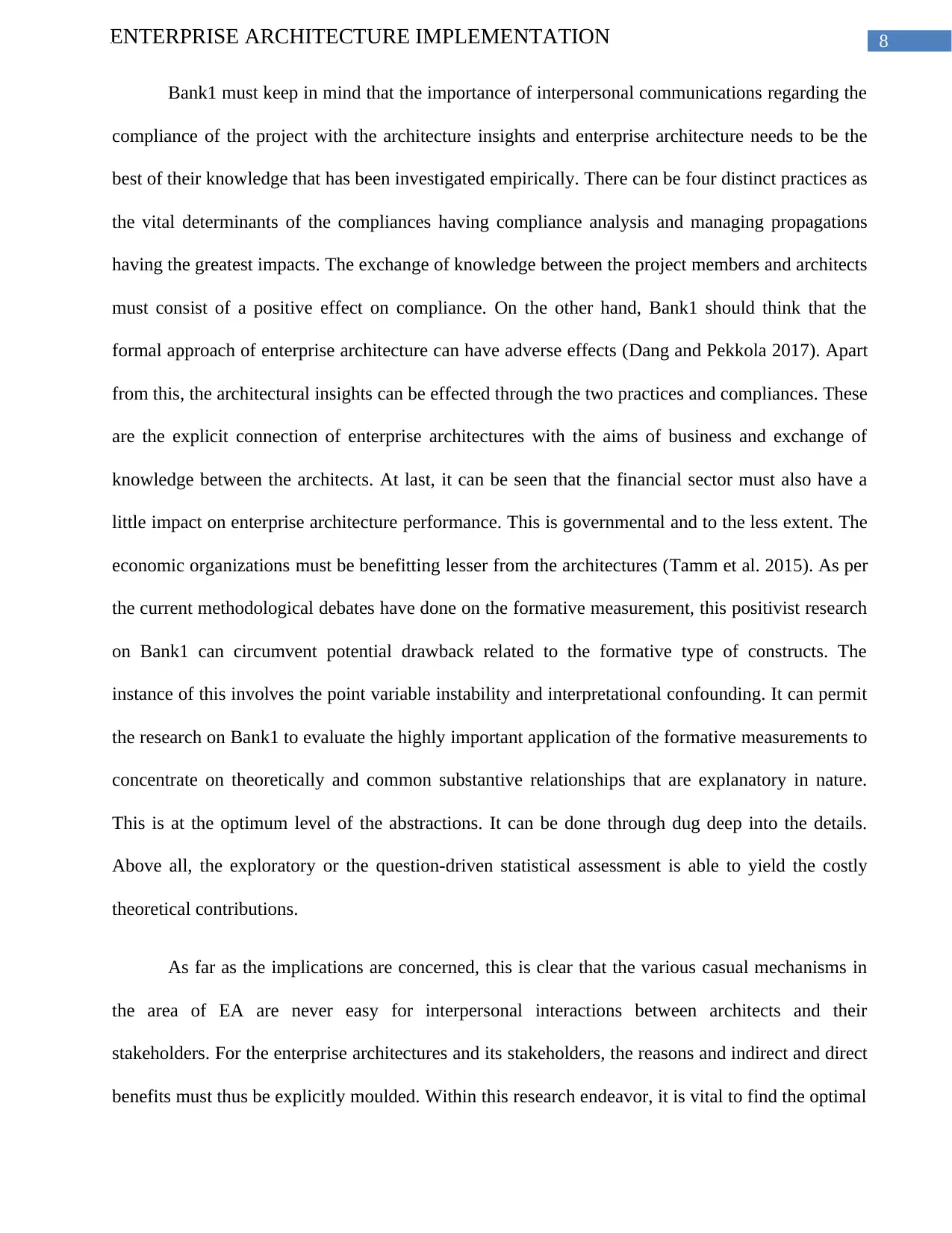
8ENTERPRISE ARCHITECTURE IMPLEMENTATION
Bank1 must keep in mind that the importance of interpersonal communications regarding the
compliance of the project with the architecture insights and enterprise architecture needs to be the
best of their knowledge that has been investigated empirically. There can be four distinct practices as
the vital determinants of the compliances having compliance analysis and managing propagations
having the greatest impacts. The exchange of knowledge between the project members and architects
must consist of a positive effect on compliance. On the other hand, Bank1 should think that the
formal approach of enterprise architecture can have adverse effects (Dang and Pekkola 2017). Apart
from this, the architectural insights can be effected through the two practices and compliances. These
are the explicit connection of enterprise architectures with the aims of business and exchange of
knowledge between the architects. At last, it can be seen that the financial sector must also have a
little impact on enterprise architecture performance. This is governmental and to the less extent. The
economic organizations must be benefitting lesser from the architectures (Tamm et al. 2015). As per
the current methodological debates have done on the formative measurement, this positivist research
on Bank1 can circumvent potential drawback related to the formative type of constructs. The
instance of this involves the point variable instability and interpretational confounding. It can permit
the research on Bank1 to evaluate the highly important application of the formative measurements to
concentrate on theoretically and common substantive relationships that are explanatory in nature.
This is at the optimum level of the abstractions. It can be done through dug deep into the details.
Above all, the exploratory or the question-driven statistical assessment is able to yield the costly
theoretical contributions.
As far as the implications are concerned, this is clear that the various casual mechanisms in
the area of EA are never easy for interpersonal interactions between architects and their
stakeholders. For the enterprise architectures and its stakeholders, the reasons and indirect and direct
benefits must thus be explicitly moulded. Within this research endeavor, it is vital to find the optimal
Bank1 must keep in mind that the importance of interpersonal communications regarding the
compliance of the project with the architecture insights and enterprise architecture needs to be the
best of their knowledge that has been investigated empirically. There can be four distinct practices as
the vital determinants of the compliances having compliance analysis and managing propagations
having the greatest impacts. The exchange of knowledge between the project members and architects
must consist of a positive effect on compliance. On the other hand, Bank1 should think that the
formal approach of enterprise architecture can have adverse effects (Dang and Pekkola 2017). Apart
from this, the architectural insights can be effected through the two practices and compliances. These
are the explicit connection of enterprise architectures with the aims of business and exchange of
knowledge between the architects. At last, it can be seen that the financial sector must also have a
little impact on enterprise architecture performance. This is governmental and to the less extent. The
economic organizations must be benefitting lesser from the architectures (Tamm et al. 2015). As per
the current methodological debates have done on the formative measurement, this positivist research
on Bank1 can circumvent potential drawback related to the formative type of constructs. The
instance of this involves the point variable instability and interpretational confounding. It can permit
the research on Bank1 to evaluate the highly important application of the formative measurements to
concentrate on theoretically and common substantive relationships that are explanatory in nature.
This is at the optimum level of the abstractions. It can be done through dug deep into the details.
Above all, the exploratory or the question-driven statistical assessment is able to yield the costly
theoretical contributions.
As far as the implications are concerned, this is clear that the various casual mechanisms in
the area of EA are never easy for interpersonal interactions between architects and their
stakeholders. For the enterprise architectures and its stakeholders, the reasons and indirect and direct
benefits must thus be explicitly moulded. Within this research endeavor, it is vital to find the optimal
⊘ This is a preview!⊘
Do you want full access?
Subscribe today to unlock all pages.

Trusted by 1+ million students worldwide
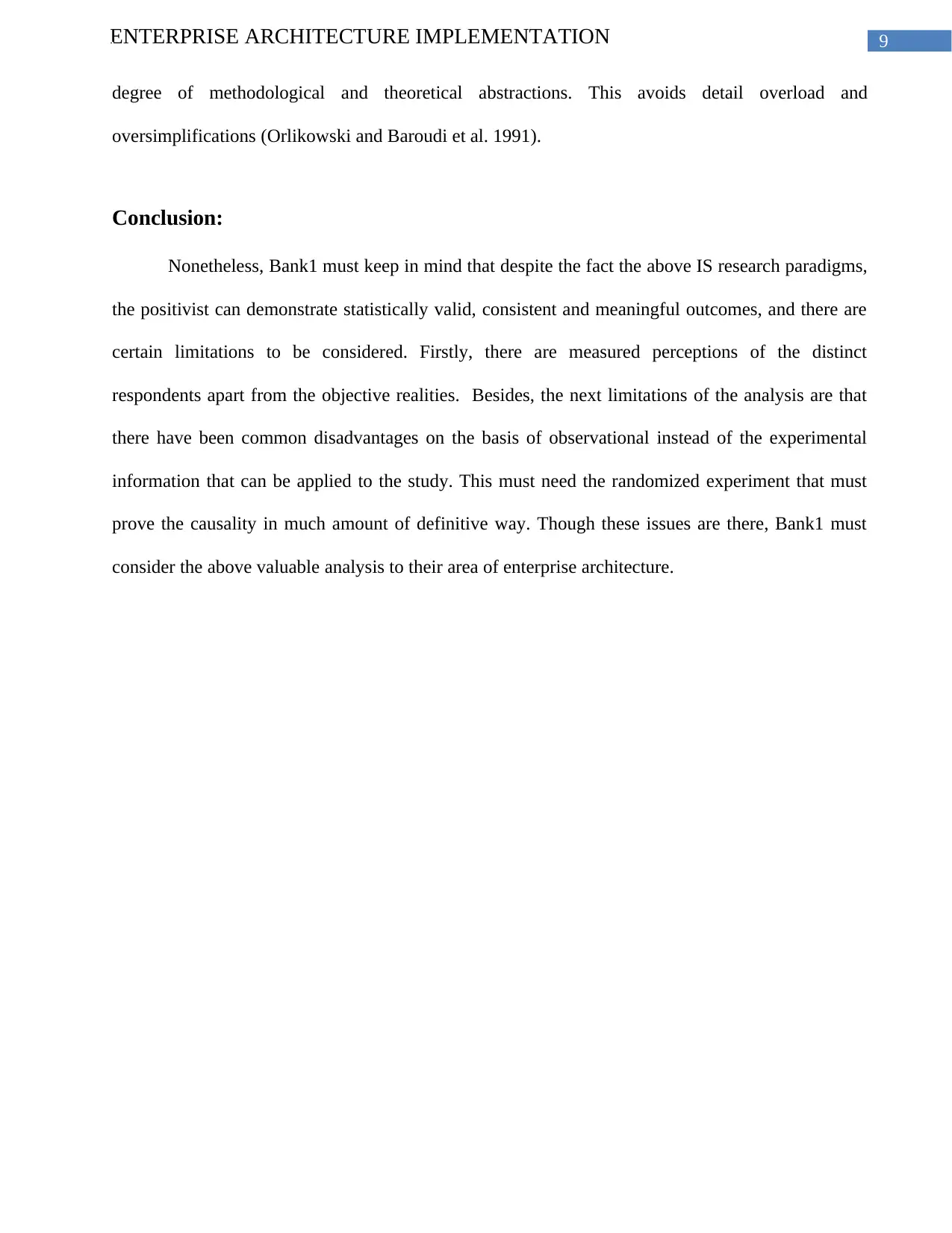
9ENTERPRISE ARCHITECTURE IMPLEMENTATION
degree of methodological and theoretical abstractions. This avoids detail overload and
oversimplifications (Orlikowski and Baroudi et al. 1991).
Conclusion:
Nonetheless, Bank1 must keep in mind that despite the fact the above IS research paradigms,
the positivist can demonstrate statistically valid, consistent and meaningful outcomes, and there are
certain limitations to be considered. Firstly, there are measured perceptions of the distinct
respondents apart from the objective realities. Besides, the next limitations of the analysis are that
there have been common disadvantages on the basis of observational instead of the experimental
information that can be applied to the study. This must need the randomized experiment that must
prove the causality in much amount of definitive way. Though these issues are there, Bank1 must
consider the above valuable analysis to their area of enterprise architecture.
degree of methodological and theoretical abstractions. This avoids detail overload and
oversimplifications (Orlikowski and Baroudi et al. 1991).
Conclusion:
Nonetheless, Bank1 must keep in mind that despite the fact the above IS research paradigms,
the positivist can demonstrate statistically valid, consistent and meaningful outcomes, and there are
certain limitations to be considered. Firstly, there are measured perceptions of the distinct
respondents apart from the objective realities. Besides, the next limitations of the analysis are that
there have been common disadvantages on the basis of observational instead of the experimental
information that can be applied to the study. This must need the randomized experiment that must
prove the causality in much amount of definitive way. Though these issues are there, Bank1 must
consider the above valuable analysis to their area of enterprise architecture.
Paraphrase This Document
Need a fresh take? Get an instant paraphrase of this document with our AI Paraphraser
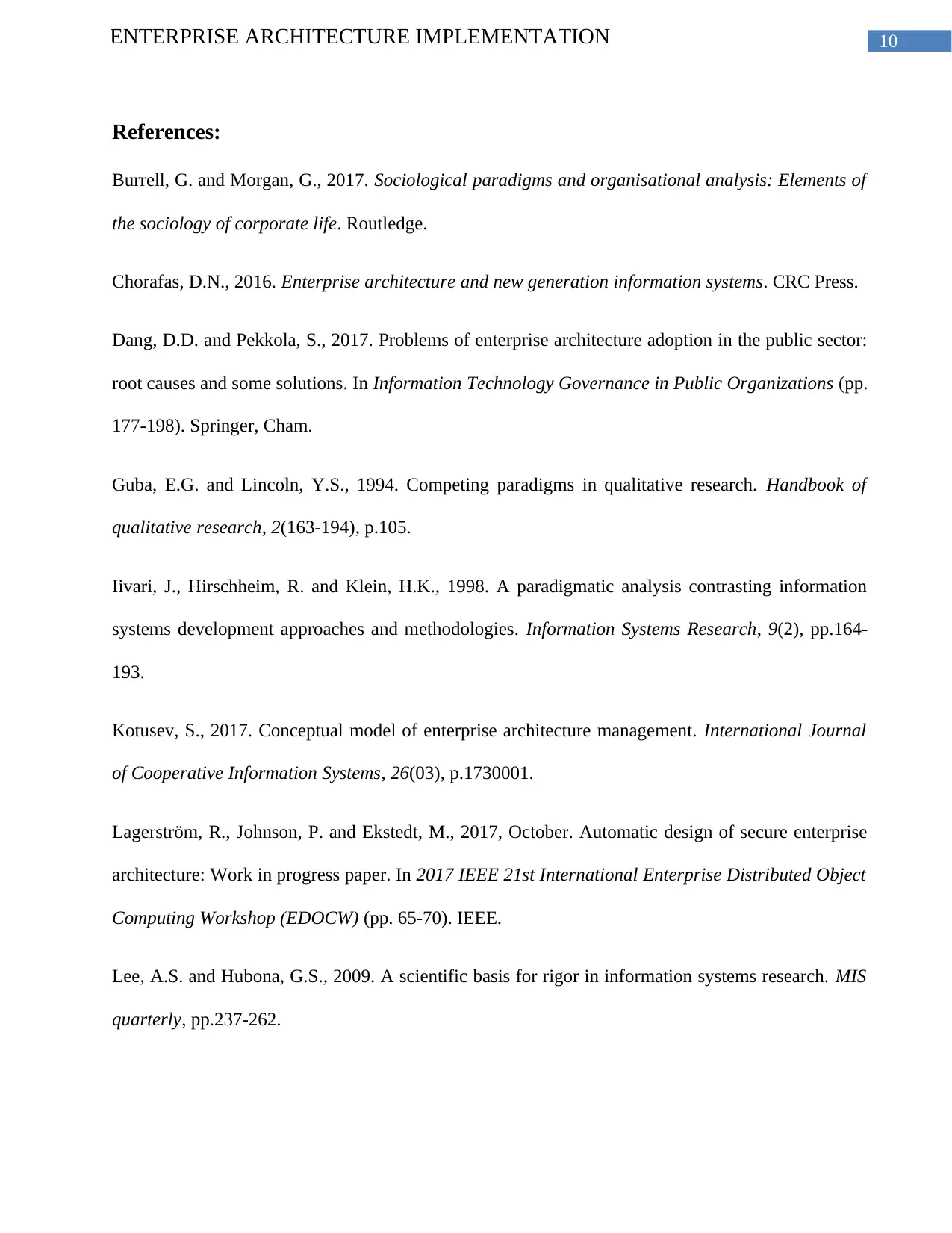
10ENTERPRISE ARCHITECTURE IMPLEMENTATION
References:
Burrell, G. and Morgan, G., 2017. Sociological paradigms and organisational analysis: Elements of
the sociology of corporate life. Routledge.
Chorafas, D.N., 2016. Enterprise architecture and new generation information systems. CRC Press.
Dang, D.D. and Pekkola, S., 2017. Problems of enterprise architecture adoption in the public sector:
root causes and some solutions. In Information Technology Governance in Public Organizations (pp.
177-198). Springer, Cham.
Guba, E.G. and Lincoln, Y.S., 1994. Competing paradigms in qualitative research. Handbook of
qualitative research, 2(163-194), p.105.
Iivari, J., Hirschheim, R. and Klein, H.K., 1998. A paradigmatic analysis contrasting information
systems development approaches and methodologies. Information Systems Research, 9(2), pp.164-
193.
Kotusev, S., 2017. Conceptual model of enterprise architecture management. International Journal
of Cooperative Information Systems, 26(03), p.1730001.
Lagerström, R., Johnson, P. and Ekstedt, M., 2017, October. Automatic design of secure enterprise
architecture: Work in progress paper. In 2017 IEEE 21st International Enterprise Distributed Object
Computing Workshop (EDOCW) (pp. 65-70). IEEE.
Lee, A.S. and Hubona, G.S., 2009. A scientific basis for rigor in information systems research. MIS
quarterly, pp.237-262.
References:
Burrell, G. and Morgan, G., 2017. Sociological paradigms and organisational analysis: Elements of
the sociology of corporate life. Routledge.
Chorafas, D.N., 2016. Enterprise architecture and new generation information systems. CRC Press.
Dang, D.D. and Pekkola, S., 2017. Problems of enterprise architecture adoption in the public sector:
root causes and some solutions. In Information Technology Governance in Public Organizations (pp.
177-198). Springer, Cham.
Guba, E.G. and Lincoln, Y.S., 1994. Competing paradigms in qualitative research. Handbook of
qualitative research, 2(163-194), p.105.
Iivari, J., Hirschheim, R. and Klein, H.K., 1998. A paradigmatic analysis contrasting information
systems development approaches and methodologies. Information Systems Research, 9(2), pp.164-
193.
Kotusev, S., 2017. Conceptual model of enterprise architecture management. International Journal
of Cooperative Information Systems, 26(03), p.1730001.
Lagerström, R., Johnson, P. and Ekstedt, M., 2017, October. Automatic design of secure enterprise
architecture: Work in progress paper. In 2017 IEEE 21st International Enterprise Distributed Object
Computing Workshop (EDOCW) (pp. 65-70). IEEE.
Lee, A.S. and Hubona, G.S., 2009. A scientific basis for rigor in information systems research. MIS
quarterly, pp.237-262.
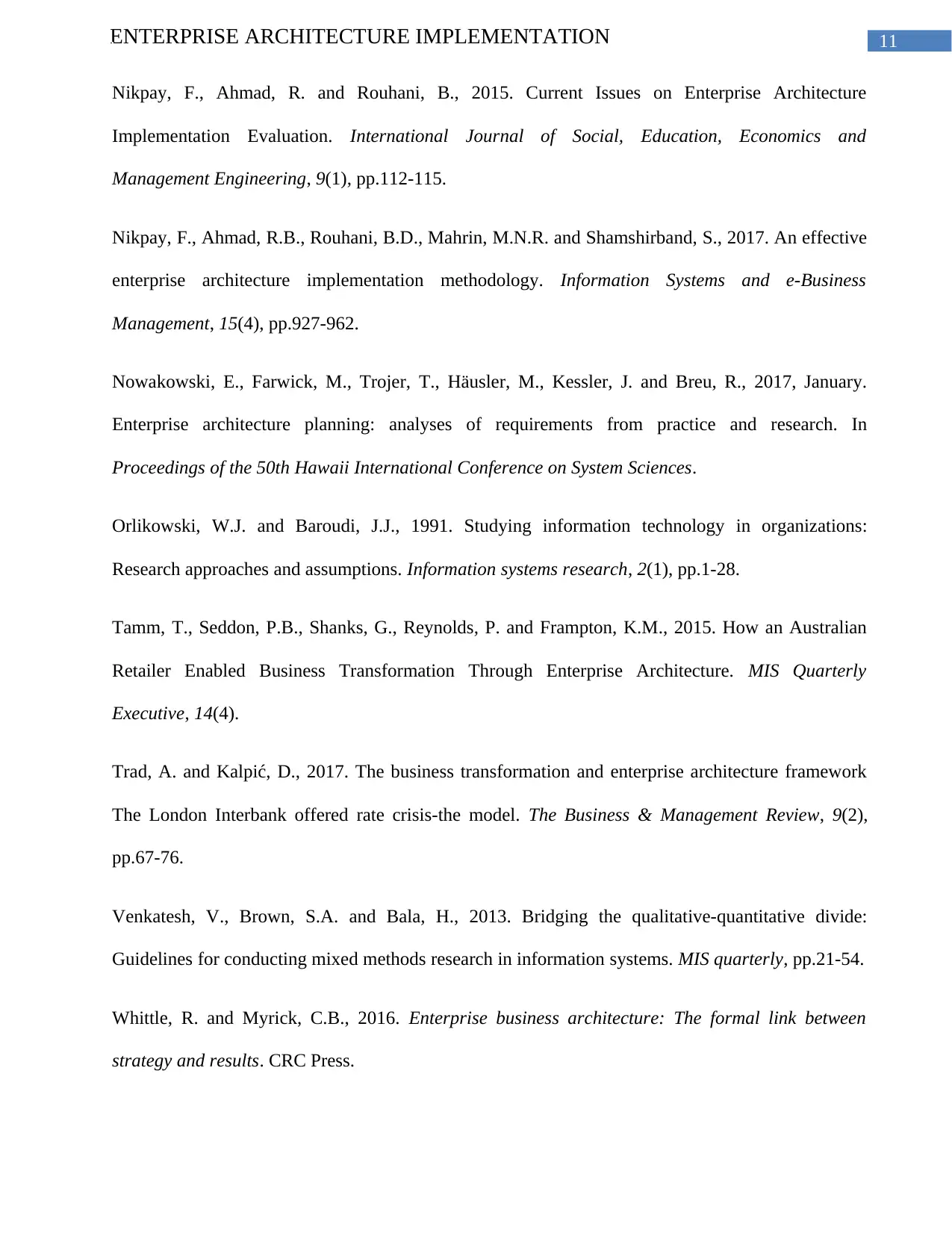
11ENTERPRISE ARCHITECTURE IMPLEMENTATION
Nikpay, F., Ahmad, R. and Rouhani, B., 2015. Current Issues on Enterprise Architecture
Implementation Evaluation. International Journal of Social, Education, Economics and
Management Engineering, 9(1), pp.112-115.
Nikpay, F., Ahmad, R.B., Rouhani, B.D., Mahrin, M.N.R. and Shamshirband, S., 2017. An effective
enterprise architecture implementation methodology. Information Systems and e-Business
Management, 15(4), pp.927-962.
Nowakowski, E., Farwick, M., Trojer, T., Häusler, M., Kessler, J. and Breu, R., 2017, January.
Enterprise architecture planning: analyses of requirements from practice and research. In
Proceedings of the 50th Hawaii International Conference on System Sciences.
Orlikowski, W.J. and Baroudi, J.J., 1991. Studying information technology in organizations:
Research approaches and assumptions. Information systems research, 2(1), pp.1-28.
Tamm, T., Seddon, P.B., Shanks, G., Reynolds, P. and Frampton, K.M., 2015. How an Australian
Retailer Enabled Business Transformation Through Enterprise Architecture. MIS Quarterly
Executive, 14(4).
Trad, A. and Kalpić, D., 2017. The business transformation and enterprise architecture framework
The London Interbank offered rate crisis-the model. The Business & Management Review, 9(2),
pp.67-76.
Venkatesh, V., Brown, S.A. and Bala, H., 2013. Bridging the qualitative-quantitative divide:
Guidelines for conducting mixed methods research in information systems. MIS quarterly, pp.21-54.
Whittle, R. and Myrick, C.B., 2016. Enterprise business architecture: The formal link between
strategy and results. CRC Press.
Nikpay, F., Ahmad, R. and Rouhani, B., 2015. Current Issues on Enterprise Architecture
Implementation Evaluation. International Journal of Social, Education, Economics and
Management Engineering, 9(1), pp.112-115.
Nikpay, F., Ahmad, R.B., Rouhani, B.D., Mahrin, M.N.R. and Shamshirband, S., 2017. An effective
enterprise architecture implementation methodology. Information Systems and e-Business
Management, 15(4), pp.927-962.
Nowakowski, E., Farwick, M., Trojer, T., Häusler, M., Kessler, J. and Breu, R., 2017, January.
Enterprise architecture planning: analyses of requirements from practice and research. In
Proceedings of the 50th Hawaii International Conference on System Sciences.
Orlikowski, W.J. and Baroudi, J.J., 1991. Studying information technology in organizations:
Research approaches and assumptions. Information systems research, 2(1), pp.1-28.
Tamm, T., Seddon, P.B., Shanks, G., Reynolds, P. and Frampton, K.M., 2015. How an Australian
Retailer Enabled Business Transformation Through Enterprise Architecture. MIS Quarterly
Executive, 14(4).
Trad, A. and Kalpić, D., 2017. The business transformation and enterprise architecture framework
The London Interbank offered rate crisis-the model. The Business & Management Review, 9(2),
pp.67-76.
Venkatesh, V., Brown, S.A. and Bala, H., 2013. Bridging the qualitative-quantitative divide:
Guidelines for conducting mixed methods research in information systems. MIS quarterly, pp.21-54.
Whittle, R. and Myrick, C.B., 2016. Enterprise business architecture: The formal link between
strategy and results. CRC Press.
⊘ This is a preview!⊘
Do you want full access?
Subscribe today to unlock all pages.

Trusted by 1+ million students worldwide
1 out of 12
Your All-in-One AI-Powered Toolkit for Academic Success.
+13062052269
info@desklib.com
Available 24*7 on WhatsApp / Email
![[object Object]](/_next/static/media/star-bottom.7253800d.svg)
Unlock your academic potential
Copyright © 2020–2025 A2Z Services. All Rights Reserved. Developed and managed by ZUCOL.
